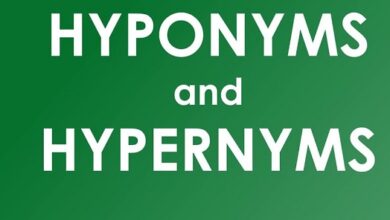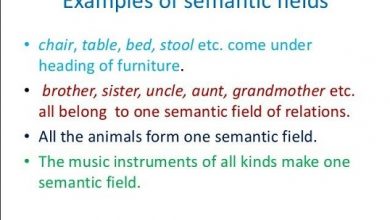Componential analysis composition and A perfect paradigm
Componential analysis
Componential analysis can be considered as the classical model of trait analysis.
First notions: lexeme and domain. Given a limited set of lexical units (lexemes) that share some meaning trait, the aim is to establish whether this set of lexemes form a domain and to discover the formal pattern of the meanings that underlie this domain.
Other basic notions: componential analysis, paradigm, taxonomy, key, tree, meaning dimension, meaning feature, reference inclusion, contrast level, etic grid and contrast set.
More about Componential analysis
Composition of Componential analysis
Componential analysis consists of a search process for:
- The dimensions of meaning that underlie a domain.
- The realization of the cartography of the values of these dimensions (the features of meaning) that appear in a given set of lexemes.
- Dimensions may be obvious and given by an etic grid (eg kinship relations), may not be obvious yet given by an etic grid (eg agnatic rank), or no grid may be available in advance ethic.
A taxonomy is the organization of a domain by reference inclusion. Taxonomy is often used when the attempt to discover the underlying dimensions has not been successful. Taxonomies usually contain levels of contrast, although it is not always possible to establish them.
A perfect paradigm is characterized by:
- In it, each componential definition corresponds to a single minimal event of classification.
- For each pair of features of a dimension, it has a correlative pair of lexemes.
- It has zero redundancy.
- The semantic dimensions are applied simultaneously.
A tree is characterized by:
- Being a maximally redundant system, in which the componential definitions contrast in more than one dimension.
- Semantic dimensions are applied sequentially.
- It requires a key for its presentation.
A key is a branching structure whose first node indicates the domain root and each subsequent node represents the selection of a single particular trait. Taxonomies, paradigms and trees are types of semantic structure, while the key is a type of representation of a semantic structure.
A segregate (denotata) is a class of objects referred to by means of a lexeme. Two segregates are in a contrasting relationship only when the difference between them is significant. A series of contrasting segregates form a contrast set.
Attributes are the properties shared by the objects of a segregate or taxon. A semantic feature (distinctive feature) corresponds to a criterial attribute of the objects of a segregate.
Polysemy, conjunctivity, mark, binary opposition, clustering
Polysemy is a widespread phenomenon (eg: Man/Woman, they are lexemes of contrast, although each of them has other meanings. Thus, man can refer generically to the human being, also to an adult in contrast to a child, etc.) Polysemy is sometimes associated with the phenomenon called brand. In Man/Woman, the marked term is the most general, man. The binary opposition was the core of structuralist analysis, this has not prevented its use by componential analysis. Another form of great importance in some taxonomies is the cluster. It consists of defining a term by several features associated with each other, as in a cluster (eg: Birds: they have beaks, feathers and wings).
The domain of kinship
The fundamental field of application of componential analysis was kinship, which was thus revealed as a domain or set of lexemes. Kinship relationships designate relationships established from a position, that of the speaker. The expression EGO is used to denote relative position in kinship analyses.
Kinship, for the whole of human societies, constitutes the basis of many systems for grouping people, systems of social organization, systems for assigning roles, systems for the formation of alliances, systems for guaranteeing social reproduction, etc. However, it is assumed that its understanding as a terminological system can reveal many of these aspects or at least help to understand it.
To carry out the analysis of kinship relationships, a set of signs is used, in principle abbreviations of the basic kinship terms in English: F (father), M (mother), B (brother), Z (sister), S ( son), D (daughter). By combining these six signs, a standard code is available with which to register the position of any individual in relation to EGO. This system of signs is part of an etic procedure.
Lounsbury, regarding the kinship systems in the Cuervo, established three rules:
- Bias Rule: A woman’s brother, as a connecting relative, is equivalent to her son, as a connecting relative. Corollary: any male in connection with the relative’s sister will be equivalent to the male in connection with the relative’s mother.
- Fusion rule: any sibling of a person who is the same sex as her, as a connecting relative, is equivalent to her. Corollary: any sibling of someone of the same sex as him (her) will be equivalent to him (her) as a reference object.
- Half-sibling rule: any of the children of one of the parents is the brother of the other.
The third of these rules is practically universal, the second is widespread, and the first is restricted.
In any set of kinship terms of any human society a logic appears, that is, it forms a structure, a system.
Adapting the methods of Lounsbury and Goodenough, Romney synthesized a procedure for finding out what different kinship terms in a given system have in common. For this he establishes the following rules:
- Minimum difference rule: the difference is reduced when, for example, in relation to a term X it does not matter if EGO is masculine or feminine.
- Rule of reciprocals: reciprocals can be reduced to the same expression. For example, the son/daughter of EGO’s brother and the brother/daughter of her father.
- Difference rule in sequence. It results from combining the two previous rules when the genealogy does not establish a difference.


